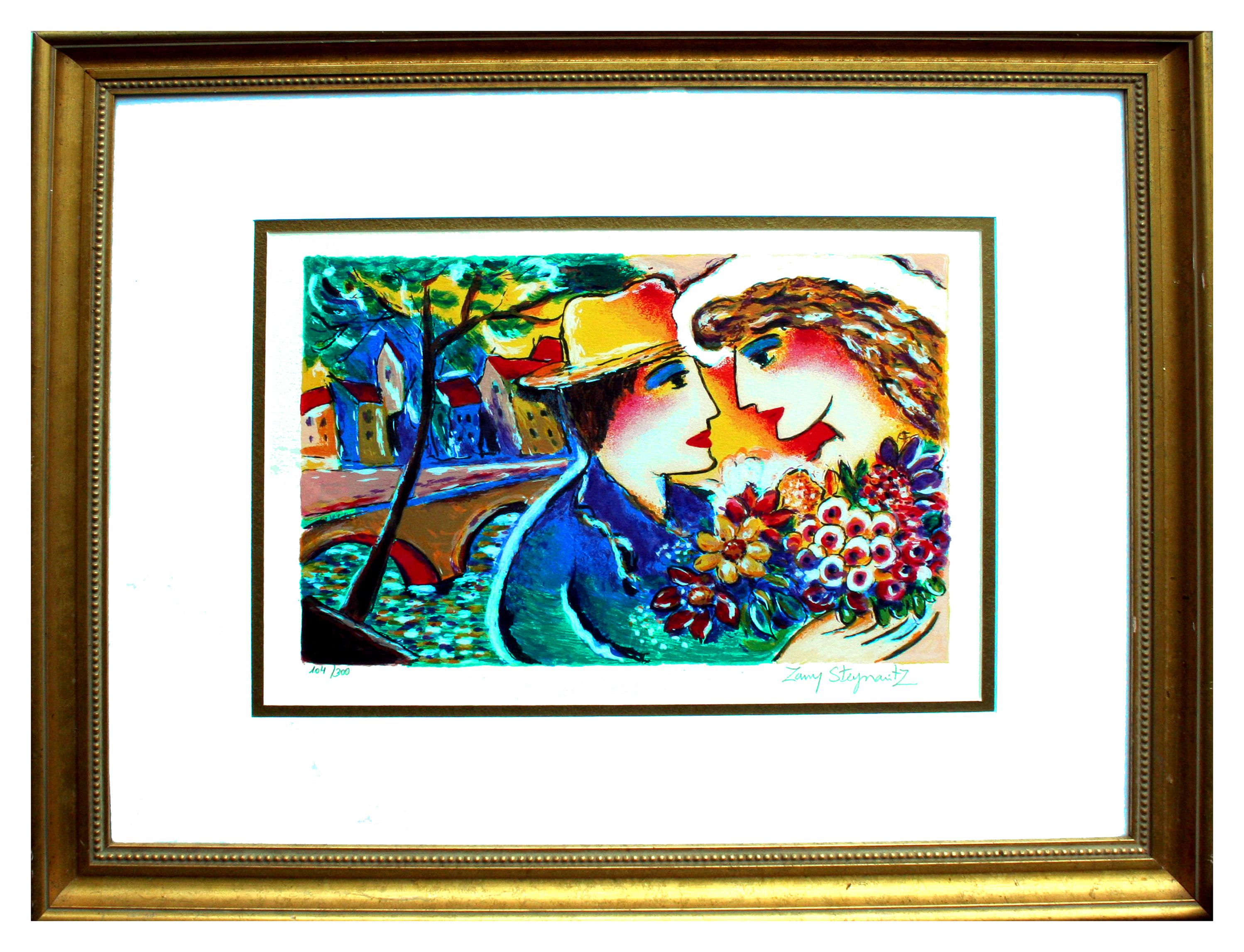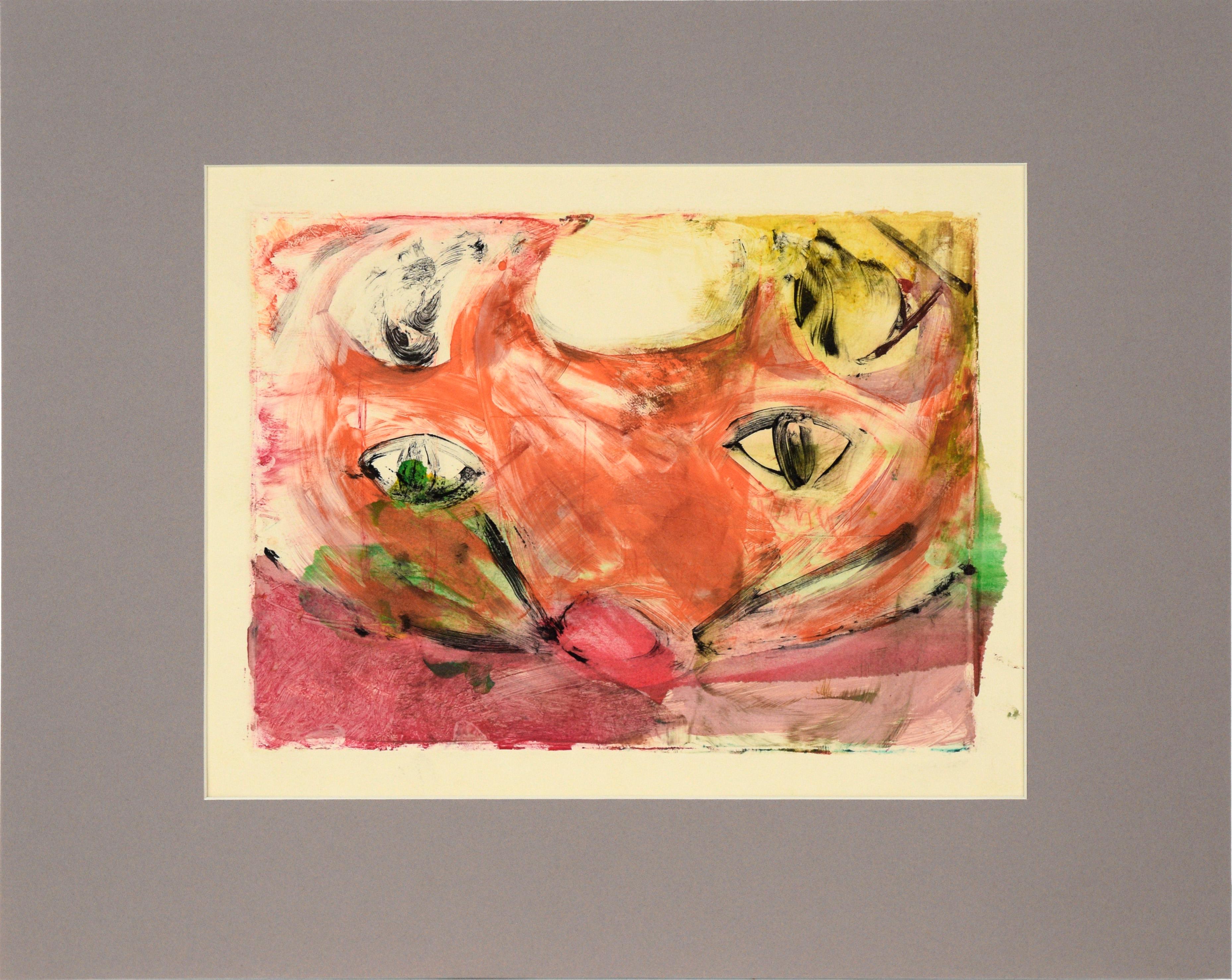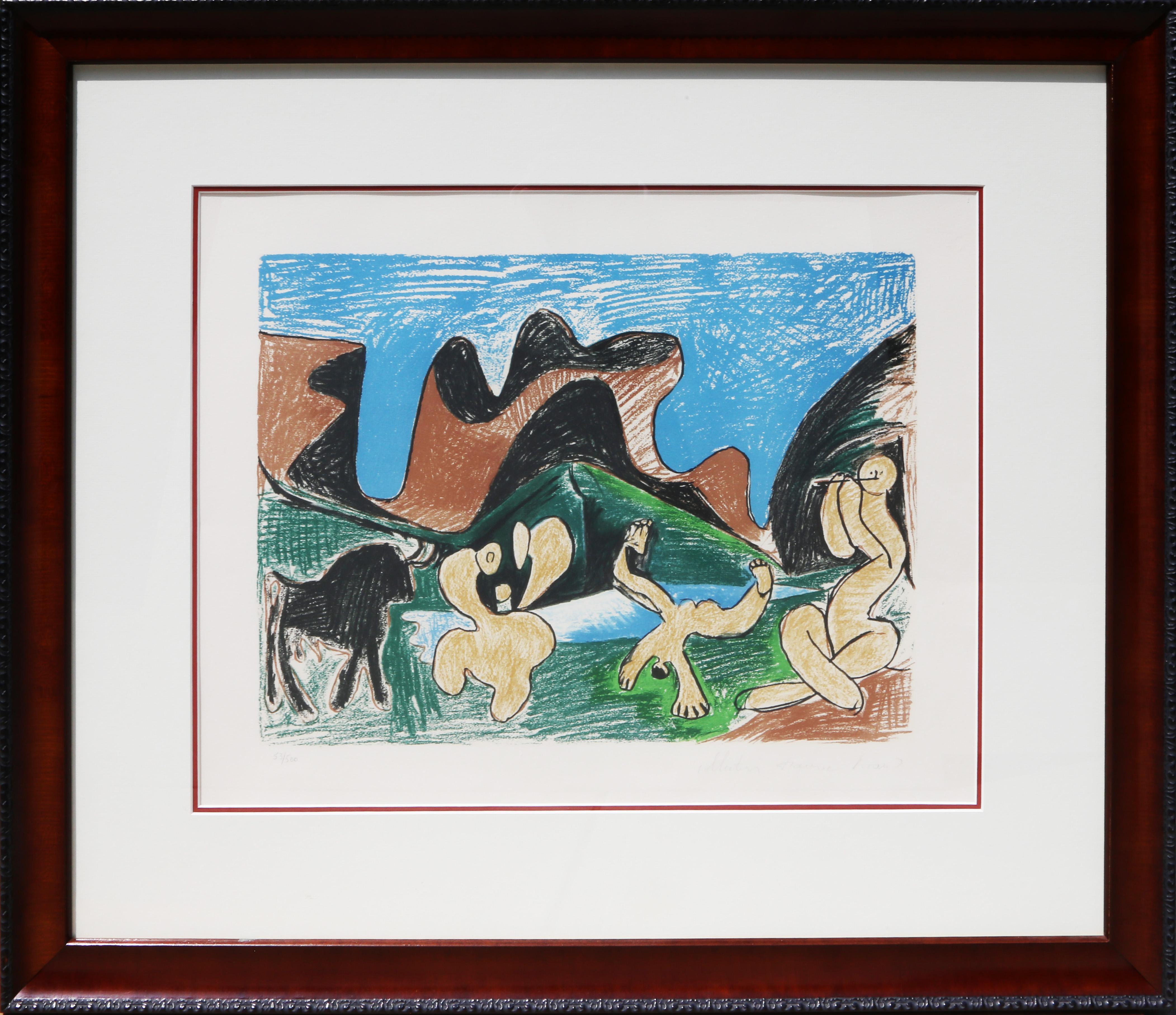Items Similar to Icarus - Screen Print After Henri Matisse - 1970s
Want more images or videos?
Request additional images or videos from the seller
1 of 2
(after) Henri MatisseIcarus - Screen Print After Henri Matisse - 1970s1940
1940
About the Item
Icarus is an original colored print realized in the 1970s after Henri Matisse.
Original colored serigraph. Very good conditions.
The artwork is from an original artwork realized by Henri Matisse in 1943–44 and it was the plate VIII for the illustrated book Jazz (1947). The illustrations derives from maquettes of cut and pasted colored papers, which were then printed using a stencil technique known as "pochoir."
Here, the mythological figure Icarus is presented in a simplified form floating against a royal blue nighttime sky.
Henri Matisse (1869-1954) is the dominant figure of Fauvism. Driving the Fauve movement was a desire to develop an art having the straightforwardness of Impressionism but employing intense color juxtapositions for expressive ends. Henri Matisse sustained that color could play a principal role in conveying meaning and focused his efforts on demonstrating this idea, exploring the effects that various colors have on emotions. He used patches and splotches of colors juxtaposed in ways that often produced upsetting contrasts.
- Creator:(after) Henri Matisse (French)
- Creation Year:1940
- Dimensions:Height: 12.68 in (32.2 cm)Width: 9.77 in (24.8 cm)Depth: 0.08 in (2 mm)
- Medium:
- Movement & Style:
- Period:
- Condition:Insurance may be requested by customers as additional service, contact us for more information.
- Gallery Location:Roma, IT
- Reference Number:
(after) Henri Matisse
Henri Matisse was born on December 31, 1869, in Le Cateau-Cambrésis, France. At 22, he had given up studying law in Paris to pursue painting. He had briefly studied art at the Académie Julian and Ecole des Beaux-Arts with Gustave Moreau. At 32, Matisse exhibited at the Salon des Indépendants in Paris, where he met Maurice de Vlaminck, who with Matisse would eventually lead the Fauve art movement. Matisse's work was included in the 1913 Armory Show in New York, and throughout the 1910s and into the 1920s, his work began to find collectors around the world. Throughout the 1920s and 1930s, he divided his time between Paris and southern France, producing paintings, sculpture, lithographs, and etchings. Like many avant-garde artists in Paris, Matisse was receptive to a broad range of influences, particularly 'primitive' art, Near Eastern decorative art, African masks and sculpture, impressionist color, cubism, and the paintings of Paul Cezanne. The artist's images of the human face and figure -rendered in fluid lines and flat fields of color- typify these influences. Matisse argued for the prominence of instinct in art production, believing that an artist should not have complete control over color and form. He died on November 3, 1954, in Nice.
About the Seller
4.9
Platinum Seller
These expertly vetted sellers are 1stDibs' most experienced sellers and are rated highest by our customers.
1stDibs seller since 2017
6,857 sales on 1stDibs
Typical response time: 3 hours
- ShippingRetrieving quote...Ships From: Monaco, Monaco
- Return PolicyA return for this item may be initiated within 14 days of delivery.
More From This SellerView All
- Jeune Hindoue - Lithograph by Henri matisse - 1929By Henri MatisseLocated in Roma, IT"Jeune Hindoue" is an original hand-signed and numbered lithograph realized by Henri Matisse in 1929. It belongs to an edition of 50 prints. Excellent condition. Reference : Duthuit...Category
1920s Fauvist Figurative Prints
MaterialsLithograph
- Jeanne Bloch - Original Lithograph on Japan Paper by H.-G. Ibels - 1893Located in Roma, ITJeanne Bloch - From Le Café Concert is an original print, realized in 1893 by Henri-Gabriel Ibels. Black and white lithograph on paper. Good conditions except for some ripple alo...Category
1890s Fauvist Figurative Prints
MaterialsLithograph
- Ouvrard - Original Lithograph on Japan Paper by H.-G. Ibels - 1893Located in Roma, ITOuvrard - From Le Café Concert is an original print, realized in 1893 by Henri-Gabriel Ibels. Black and white lithograph on paper. Good conditions except for some ripple along th...Category
1890s Fauvist Figurative Prints
MaterialsLithograph
- Torse, Fond à Losanges - Drypoint on China by H. Matisse, 1929By Henri MatisseLocated in Roma, ITImage size: 8.6x13.9 cm. Original drypoint on Chine Appliqué realized by Matisse in 1929 in an edition of only 25 prints. Signed and numbered in pencil lower right. Excellent conditi...Category
1920s Fauvist Figurative Prints
MaterialsDrypoint
- Kam-Hill - Original Lithograph on Japan Paper by H.-G. Ibels - 1893Located in Roma, ITKam-Hill - From Le Café Concert is an original print, realized in 1893 by Henri-Gabriel Ibels. Black and white lithograph on paper. Good conditions except for some ripple along ...Category
1890s Fauvist Figurative Prints
MaterialsLithograph
- Libert - Original Lithograph on Japan Paper by H.-G. Ibels - 1893Located in Roma, ITLibert - From Le Café Concert is an original print, realized in 1893 by Henri-Gabriel Ibels. Black and white lithograph on paper. Good conditions except for some ripples and some...Category
1890s Fauvist Figurative Prints
MaterialsLithograph
You May Also Like
- Bride & Groom - Fauvist Figurative LandscapeBy Zamy SteynovitzLocated in Soquel, CAColorful Fauvist screen print of a bride and groom with flowers in front of a colorful cityscape by Zamy Steynovitz (Polish, 1951-2000). Numbered "104/...Category
Late 20th Century Fauvist Figurative Prints
MaterialsInk, Paper, Screen
- Mother and Child at Eiffel TowerBy Marc ChagallLocated in Washington, DCArtist: Marc Chagall Medium: Original lithograph Title: Mother and Child at Eiffel Tower Portfolio: Paris - Derriere le Mirior Year: 1954 Edition: 2500 Framed Size: 19" x 23" Image S...Category
1950s Fauvist Figurative Prints
MaterialsLithograph
- Young girl Combing her Hair - Signed Woodcut - Fauve ArtBy Maurice de VlaminckLocated in London, GBMAURICE DE VLAMINCK 1876-1958 Paris 1876-1958 Rueil-la-Gadelière, Eure-et-Loir (French) Title: Young girl Combing her Hair Jeune fille se coiffant, 1906/1957 Technique: Original Hand Signed and Numbered Woodcut...Category
1950s Fauvist Figurative Prints
MaterialsWoodcut
- Colorful Cat Face - Transfer Monotype in Water Based Ink on PaperLocated in Soquel, CAColorful Cat Face - Transfer Monotype in Water Based Ink on Paper Original transfer monotype painting by California artist Heather Speck (American, 20th...Category
1990s Fauvist Figurative Prints
MaterialsPaper, Monotype, Ink
- Bacchanale, Cubist Lithograph by Pablo PicassoBy Pablo PicassoLocated in Long Island City, NYA lithograph from the Marina Picasso Estate Collection after the Pablo Picasso painting "Bacchanale". The original painting was compl...Category
1980s Fauvist Figurative Prints
MaterialsLithograph
- "Mlle Landsberg" (grade planche, pl. 16)By Henri MatisseLocated in Missouri, MO"Mlle Landsberg" (grade planche, pl. 16), 1914 Henri Matisse (French, 1869-1954) Signed and Numbered Lower Right Edition 12/15 Image size: 7 7/8 x 4 5/16 inches Sheet size: 17 11/16 x 12 1/2 inches With frame: 19 1/2 x 14 1/2 inches Henri Matisse came from a family who were of Flemish origin and lived near the Belgian border. At eight o'clock on the evening of December 31, 1869, he was born in his grandparents' home in the town of Le Cateau in the cheerless far north of France. His father was a self-made seed merchant who was a mixture of determination and tightly coiled tension. Henri had no clear idea of what he wanted to do with his life. He was a twenty-year-old law clerk convalescing from appendicitis when he first began to paint, using a box of colors given to him by his mother. Little more than a year later, in 1890, he had abandoned law and was studying art in Paris. The classes consisted of drawing from plaster casts and nude models and of copying paintings in the Louvre. He soon rebelled against the school's conservative atmosphere; he replaced the dark tones of his earliest works with brighter colors that reflected his awareness of Impressionism. Matisse was also a violinist; he took an odd pride in the notion that if his painting eye failed, he could support his family by fiddling on the streets of Paris. Henri found a girlfriend while studying art, and he fathered a daughter, Marguerite, by her in 1894. In 1898 he married another woman, Amelie Parayre. She adopted the beloved Marguerite; they eventually had two sons, Jean, a sculptor and Pierre who became an eminent art dealer. Relations between Matisse and his wife were often strained. He often dallied with other women, and they finally separated in 1939 over a model who had been hired as a companion for Mme. Matisse. She was Madame Lydia, and after Mme. Matisse left, she remained with Matisse until he died. Matisse spent the summer of 1905 working with Andre Derain in the small Mediterranean seaport of Collioure. They began using bright and dissonant colors. When they and their colleagues exhibited together, they caused a sensation. The critics and the public considered their paintings to be so crude and so roughly crafted that the group became known as Les Fauves (the wild beasts). By 1907, Matisse moved on from the concerns of Fauvism and turned his attention to studies of the human figure. He had begun to sculpt a few years earlier. In 1910, when he saw an exhibition of Islamic art, he was fascinated with the multiple patterned areas and adapted the decorative universe of the miniatures to his interiors. As a continuation of his interest in the "exotic", Matisse made extended trips to Morocco in 1912 and 1913. At the end of 1917, Matisse moved to Nice; he would spend part of each year there for the remainder of his life. A meticulous dandy, he wore a light tweed jacket amd a tie when he painted. He never used a palette, but instead squeezed his colors on to plain white kitchen dishes...Category
1910s Fauvist Figurative Prints
MaterialsEtching, Drypoint
Recently Viewed
View AllRead More
At MoMA, Matisse’s Famed ‘Red Studio’ Painting Is Re-Created in Real Life
The French artist's expressive depiction of his atelier is filled with small portrayals of his other works. Now, those pieces are sharing a room with the canvas for the first time since Matisse painted it.
5 Reasons to Collect Art
From discovering new mediums to supporting rising talents, there are many good motives for building a collection of meaningful works. Learn the hows and whys of art collecting with our guide.
More Ways To Browse
After Vintage
Henri Matisse Jazz
Henri Matisse Print Jazz
Matisse Pochoir
Matisse Jazz Book
Icarus Figure
Henri Matisse Icarus
Icarus Matisse
Le Mans Retro Poster
Louis Gerard
Map Of Italy Vintage
Marc Chagall Bella
Mid Century African American Portrait
Mid Century Charcoal And Ink
Northern Song
Notre Dame Lithograph
Nude Female Wall Hanging
Peter Max 1999






